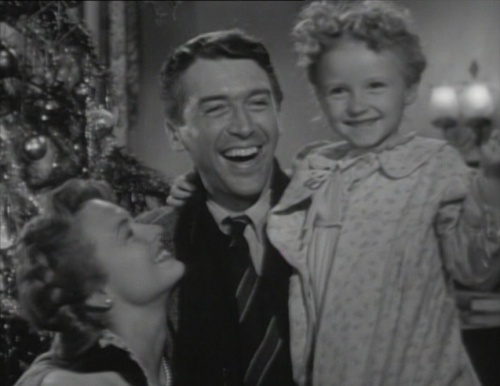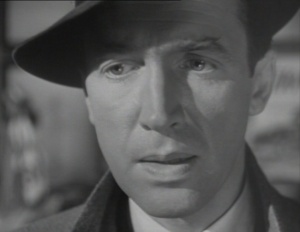 It’s a Wonderful Life (Frank Capra, 1946)
It’s a Wonderful Life (Frank Capra, 1946)
In his autobiography The Name Above the Title, Frank Capra was straightforward in his self-assessment of It’s a Wonderful Life. “I thought it was the greatest film I had ever made,” he wrote, adding: “Better yet, I thought it was the greatest film anybody had ever made.” We might fault Capra for saying it himself, but the passage of time has largely vindicated his hubris. As fewer and fewer films from the middle of the twentieth century are revived, It’s a Wonderful Life remains one of the perennial standards, still widely loved by popular audiences rather than just a hard core of film buffs. Its impact on audiences remains strong: the dulling of impact usually wrought by the passage of time has not appreciably weakened the film. This is particularly surprising given the its firm footing in its time. The film expresses many of the fears and hopes of America after World War II, and is one of the most rewarding films to study in looking at the values espoused by Hollywood at the start of the post-war era.
We do the film a disservice, though, if we only consider it as a social document and forget its value as an entertainment. As a film designed to get an emotional response, it is about as effective as any made. This at first seems to be for straightforward reasons. It is a sentimental story of an impossibly good man – George Bailey, played by one of the twentieth century’s most charismatic actors, James Stewart – who gives up many of his dreams to support his family, friends, and community. Bailey falls on bad times, is mistreated, and loses faith… only to regain it at the conclusion of the film. Broadly speaking, it’s a classic Hollywood trajectory and the impact of the film might therefore seem not at all mysterious. The extreme goodness of Bailey gets us on-side, and we have a hissable villain to contrast him with in the corrupt developer Henry Potter. The misfortunes that fall upon our good character arouse our sympathies, and we can cheer when he overcomes them. Yet there’s something more going on here than this standard storytelling device. Beyond the broad sweep of the story, the film’s approach is actually highly unusual and rarely imitated.
The first unusual element is the exact way in which the film elicits its emotional response. On closer examination, it turns out to be misleading to say the film gets us on-side simply by showing us a good character mistreated: the film’s emotional triggers are much more complex than such a simple “strike-the-puppy” emotional manipulation. As Danny Peary points out in a great essay on the film in his book Cult Movies, the film doesn’t actually get its strongest emotional response in the scenes where George is at his lowest ebb (the one exception, perhaps, is the scene where he lashes out at his children, and even then, it’s the kids, not George, that we feel for). Instead, the film’s emotional catharsis comes from the scenes in which characters are kind to each other and behave well. We are moved not by misfortune or injustice, but rather by their love, generosity, and communal spirit.
This is the sense in which the film is most sentimental: except for Potter, the film makes everyone out to be essentially good-hearted. A lesser film, for example, might have made a secondary villain out of the character of Violet: the good-time girl who fancies George and competes with eventual wife Mary for his attentions. She is, basically, a femme fatale character, contrasted with Mary’s clear alignment with family values and domesticity. Yet Capra never shows Violet making inappropriate advances on George: she only flirts with him when he’s single, and when George and Mary marry, Violet is shown prominently cheering and genuinely happy for them. Similarly, George’s romantic rival for Mary, Sam Wainwright, continually offers to help George by giving him business opportunities. At every turn, Capra avoids the usual narrative device of showing bad characters getting their comeuppance and instead focuses on good people doing good things for each other. Even Henry Potter, the one-man repository of all that is bad about the town of Bedford Falls, never gets punished or even rebuked for his crimes. It is enough that the good characters save George, and no vengeance is necessary.
The other interesting thing about the film is its extreme shifts from emotional highs to lows. While the general thrust of the film follows a typical progression from setup, to crisis, to resolution, I can think of few films that use so many abrupt shifts from moments of good fortune and positive emotion to moments of tragedy and despair. So George and Mary start their romance as they walk home in a light-comedic scene after the high school dance, but are interrupted when Uncle Billy arrives and tells George that his father has had a stroke; when George and Mary marry, their wedding celebrations are interrupted by a run on the Building and Loan that requires them to sacrifice their savings to keep the business afloat. These abrupt emotional shifts reflect the extreme gulf between the highs and lows we see in George Bailey’s character and fortunes, and Capra isn’t afraid to pull us jarringly from one state to the other.
James Stewart’s performance is a key to making this work, alternating smoothly between the likable everyman typical of his early roles and the darker characters he would explore later in his career. George foregoes all that he wants for the good of those around him, and at a couple of vital moments Capra dramatically breaks from his generally unobtrusive use of mid-shots to let Stewart show glimpses of George’s inner turmoil. In the scene where George is called on to save the Building and Loan at the expense of his overseas trip, Capra has Stewart walk into an extreme close-up in which the audience (unlike the characters) can see just how stricken Bailey is by the development (this is the shot at the top of this page). In another moment, George finds out that his brother Harry has been offered a job that would take him away from town and again prevent George’s escape. Again, Capra isolates George from the crowd and we see his face full of shifty-eyed calculation about the effect on his own dreams: this is followed by a very powerful pan right as George walks into the crowd of family and just hides all trace of his own disappointment, forcing smile only a moment before he joins them (below).
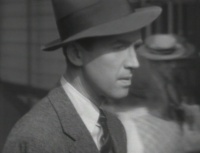 |
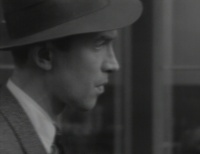 |
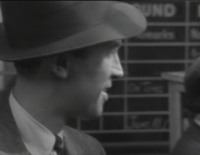 |
George’s conflict is resolved at film’s end by his realisation of how much he has gained from his family and community in return for his devotion to them, and in that sense the film perhaps seems predictably ideologically conventional. Yet what has captured the attention of many critics over the years is how emphatically it maps out George’s frustration before it papers over it again. George’s desire to leave what he calls a “crummy old town” is expressed with some venom several times in the film, and it is his family that come between him and his dreams. In another of this film’s extreme emotional shifts (this time from a negative emotion to a positive one), George’s romance with Mary begins with him rudely rebuffing her and then, with a kind of desperate hysteria, telling her:
Now you listen to me! I don’t want any [career in] plastics, and I don’t want any ground floors, and I don’t want to get married ever, to anyone! You understand that? I want to do what I want to do… and you’re… and you’re…
At which point he breaks down and kisses her; we then cut immediately to their marriage. The lingering sense that he has somehow given in and married Mary almost against his wishes is revived later, as his life falls apart and he prowls through the house verbally lashing out at both Mary and his children:
It’s this old house – I don’t know why we don’t all have pneumonia. Drafty old barn! It’s like living in a refrigerator. Why did we have to live here in the first place, and stay around this measly, crummy old town? … You call this a happy family? Why did we have to have all these kids?
Capra might ultimately show George disavowing such resentment, but this can’t erase the intensity with which it is expressed. As Robin Wood put it in his famous essay about the film, “Ideology, Genre, Autuer:”
It’s a Wonderful Life manages a convincing and moving affirmation of the values (and value) of bourgeois family life. Yet what is revealed, when disaster releases George’s suppressed intentions, is the intensity of his resentment of the family and desire to destroy it…1
I think one reason this seems particularly striking is that It’s a Wonderful Life never hides the compromise George must make: yes, he gets the love and devotion of his family, but he must give up his hopes and dreams too. This is unusual in Hollywood films, which eschew compromise and usually give their heroes everything they want: choices between personal desire and communal responsibility are presented as a transient test of character, rather than a permanent, binding decision. So, for example, if a hero has to give up his dream job and dream girl for a greater good, he’ll do so to prove his worth, but somehow nevertheless end up with both job and girl at film’s end. Capra doesn’t use such a cop-out. George learns to accept his life, but still doesn’t realise his dreams, and the film foregrounds this sacrifice rather than weaselling its way around it.
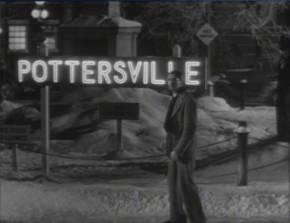 |
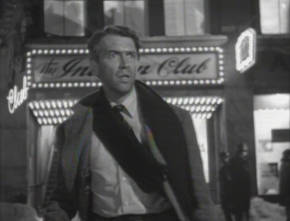 |
The other element of the film that provokes some unease is the apparent tenuousness of the good life. This is partly due to the aforementioned emotional shifts, which condition us to half expect disaster every time things are going well for George. Yet the central fantasy section of the film is even more disconcerting in that it states quite directly that the community, while full of good will, would be completely lost without the philanthropic George Bailey. As Robert B. Ray puts it, the film “implicitly [discredits] every common man but George, without whom average citizens become drunkards, poisoners, old maids, prostitutes, bullies, madmen, and embittered old women.”2 It’s not uncommon, of course, for films to play up the important difference one very good individual can make, but they are usually silent on what would have happened if that person hadn’t been there. Perhaps the implicit assumption in such stories is a kind of zen belief that there will always be a hero: someone will rise to ensure good triumphs. Again, though, It’s a Wonderful Life is unusually direct in confronting the downside of its happy ending: without George Bailey, nobody else will resist Henry Potter, and Bedford Falls is stuffed.
I’m normally reluctant to try to read the mood of a population from the films of a time, but here it’s hard to resist seeing It’s a Wonderful Life as reflective of the psyche of the immediate postwar era. It is understandable that a country – a world – having just emerged from war could be at once optimistic and yet more willing to acknowledge the dark side of life than audiences even a few years later. It’s a Wonderful Life catches that mixed mood, and uses the battle of wills between George and Potter to address the challenges before the United States as it emerged from the war: would all get to share in the new era of prosperity (as George wants) or would only a few get to profit (as Potter would have it)? Does the embrace of that postwar prosperity and freedom mean a descent into noir decadence, as in the Pottersville sequence, or can people like George put family and community (re)building first, leading to the genteel, family oriented suburban future hinted at in the Bailey park sequences? As I’ve suggested in my discussion of small town films of the 1940s (here), Capra ultimately affirms his belief in the prospects for a suburban future in which all will enjoy the post-war good times, and the small-town values of Bedford Falls will live on. Yet just as he acknowledges the dilemmas facing George in his personal life, the film also gives a disquieting sense of the perils facing America after the war.
With so many juicy ambiguities and contradictions to mull over, it should be little wonder that the film has remained a favourite of film critics and theorists. Yet its ultimate appeal remains the emotional rush it brings. The film’s concluding minutes might be its corniest – they take a sentimental but hard-edged tale into the purely saccharine – but they perfectly pay off what has come before, providing a powerful and cathartic conclusion that is still effective over sixty years later. Little wonder Capra was so pleased with himself.
Notes
1. Robin Wood, “Ideology, Genre, Auteur,” Film Comment 13, no. 1 (1977): 49.
2. Robert B. Ray, A Certain Tendency of the Hollywood Cinema, 1930-1980 (Princeton: Princeton University Press, 1985), 202.
Related Items
For my essay on small town films of the 1940s such as It’s a Wonderful Life and Our Town, click here.
